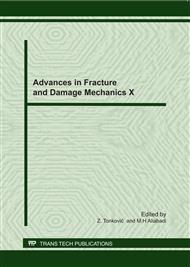p.182
p.186
p.190
p.194
p.198
p.202
p.206
p.210
p.214
Influence of Curing Temperature on the Mechanical Properties of Alkali-Activated Bottom Ash Geopolymer Mortar
Abstract:
The fabrication of Portland cement causes numerous problems accompanying the large exhaustion of gas. Even if fly ash, an industrial by-product produced in thermoelectric power plants, is recycled in concrete by partial replacing of cement, more than 50% remains still discharged in marine and ashore landfills and, continue to provoke environmental problems. Recently, active research has been dedicated to alkali-activated concrete that does not use cement as binder. This alkali-activated concrete as a cement zero concrete activated by alkali solution using bottom ash rich in Si and Al instead of cement is effective in reducing gas exhaustion. This study is a basic research for the fabrication of concrete without cement and using 100% of bottom ash among the industrial by-products. Therefore, the purposes are to develop cement zero concrete by evaluating the mechanical properties by age according to the change of the molar concentration and ratio (SH/SS) of the alkali-activator and the curing temperature, and to investigate the reaction mechanism. From the test results, the compressive strength increased with larger molar concentration and the optimal curing temperature was 60°C. In addition, the measurement of the leaching according to the molar concentration of fly ash having similar chemical composition showed that the leaching of Si4+ and Al3+ increased. Compared to 6M, the leached quantities of Si4+ and Al3+ were twice larger for 9M and 12M. The formation of gel at the surface of fly ash indicated that fly ash was more activated in higher alkaline environment.
Info:
Periodical:
Pages:
198-201
Citation:
Online since:
September 2011
Authors:
Price:
Сopyright:
© 2012 Trans Tech Publications Ltd. All Rights Reserved
Share:
Citation:


